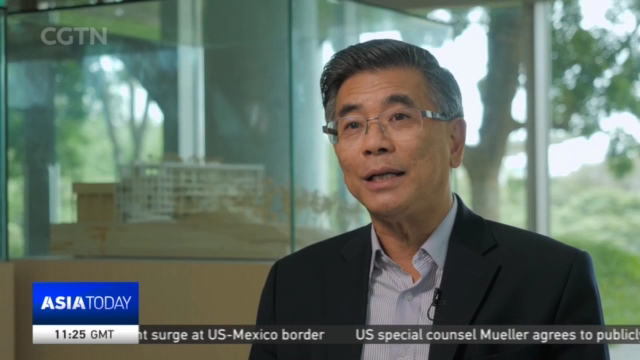
19:39, 26-Jun-2019
Green & Sustainable Buildings: Singapore zero-energy building: A prototype of sustainable design
Updated
17:08, 09-Jul-2019

Singapore's National University finished constructing its environment-friendly, zero energy building earlier this year. The new structure is energy efficient with a focus on improving the comfort and well-being of its occupants. It houses research laboratories, design studios, and common learning spaces. CGTN's Miro Lu takes you on a tour of the state-of-the-art complex.
MIRO LU SINGAPORE "This may look like an ordinary building, but this structure is anything but ordinary. We are at the Singapore National University, and this is the School of Design and Environment's first net-zero energy building."
Net-zero energy essentially means that the building produces more energy than it consumes. Known as SDE4, the complex receives its energy through more than 1200 solar panels situated on the roof. However, using solar power is only part of the energy equation.
Professor Lam Khee Poh, who is the dean of the School of Design and Environment, which spearheaded the project explained that - reducing the use of air conditioning was key to managing SDE4's energy consumption. Inspired by traditional Malay homes, the building uses solutions like high ceilings, an extended roof, and open spaces to combat Singapore's tropical heat.
LAM KHEE POH, DEAN SCHOOL OF DESIGN & ENVIRONMENT, NATIONAL UNIV. OF SINGAPORE "We need to shade. It is just as simple as that. The minute you provide shading, you reduce the impact of the solar radiation on to your building and transmitting that inside the building. Once you reduce that then you don't have to spend so much energy cooling it. Number two is really to provide as much opportunity for ventilation, natural ventilation of spaces as possible."
An interesting innovation is the use of curtain-like aluminum panels on the east and west facades of the building.
Another feature that is unique to the structure is its "Hybrid cooling system".
LAM KHEE POH, DEAN SCHOOL OF DESIGN & ENVIRONMENT, NATIONAL UNIV. OF SINGAPORE "This is what they used to do – fans, ceiling fans. That technology has been around for a long long time. It has been a very efficient way of creating ventilation. So, we brought that back and we combined this with the air conditioning and this gave rise to what we call hybrid air conditioning system."
Apart from energy-saving, "Wellness" of its occupants has heavily influenced the design concept - whether it is the extensive use of glass or incorporating existing trees into the main complex. And unlike regular air-conditioned buildings in Singapore which recycle up to 90 percent of their air, SDE4's sustainable design allows it to provide better air quality to its occupants.
CHRISTOPHER LEE PRINCIPAL ARCHITECT, SERIE ARCHITECTS "For a net-zero energy building it is very transparent and very open. So it is something that we felt that we could still do to create very beautiful, comfortable, light-filled spaces and at the same time be very sustainable."
The School of Design and Environment has applied for certification from the International WELL Building Institute, which recognizes best practices in construction with people's wellness in mind. If approved, it will be the first building in Singapore to reach such standards.
MIRO LU SINGAPORE "SDE4 is an inspiration for other net-zero energy buildings in Singapore. With the construction sector contributing a quarter of Singapore's total carbon emissions, buildings like these are paving the way for the country's vision towards achieving sustainable development. Miro Lu, CGTN, Singapore."
SITEMAP
Copyright © 2018 CGTN. Beijing ICP prepared NO.16065310-3
Copyright © 2018 CGTN. Beijing ICP prepared NO.16065310-3